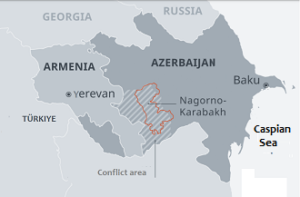
War attrition and peace in Nagorno-Karabakh
As the Russian/Ukrainian war enters a phase of attrition, a border region has a sign of peace, even if it means a loss of territory.
attrition, a border region has a sign of peace, even if it means a loss of territory.
The struggle for dominance over the Armenian-majority region of Nagorno-Karabakh goes back centuries, however the president of the self-declared republic of Nagorno-Karabakh, Samvel Shaharamanyan declared that it would cease to exist from the 1st. January 2023.
In the 18th century, when the region was under pressure from Persia, Russian Tsarina Catherine II issued letters of protection to them, but the conflict was never fully resolved.
The signed decree dissolved all state institutions that will be vacated by the beginning of 2024, and more than 100,000 Armenians have already left the country, which already has the presence of military personnel from Azerbaijan, with a Muslim majority and supported by Turkey, Armenia is Christian and supported by Russia.
The region has geopolitical importance because since Russia’s war against Ukraine, Azerbaijan has supplied millions of barrels of oil to the European Union through the Caspian Sea along the Mediterranean coast, and recently Russia announced that it will no longer supply it.
The Armenian genocide of 1915-1916 during the Otman Empire led many Armenians to flee to this region of Nagorno-Karabakh, since then they have been called Azeris, during the Russian revolution the region continued in conflict with Azerbaijan, although both were Soviet republics, the anti-Armenians in the city of Shusha killed 30 thousand Armenians.
With the end of the Soviet Union, the Armenians once again established themselves as a nation, but the Nagorno-Karabakh conflict remained, there were several periods of fighting in the region, now with the session of the territory this autonomous republic ceases to exist.
Despite the fears of separatist Armenians, this new situation is a great sign of peace.
Russia and Ukraine can be inspired by this model or something similar, the world wants peace.









